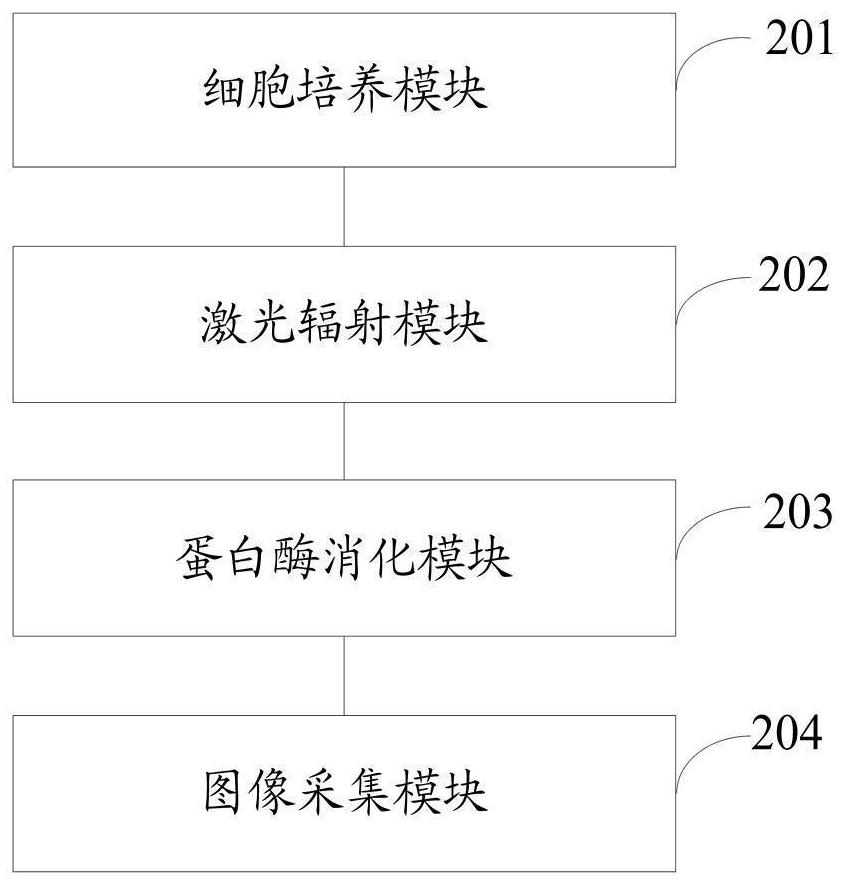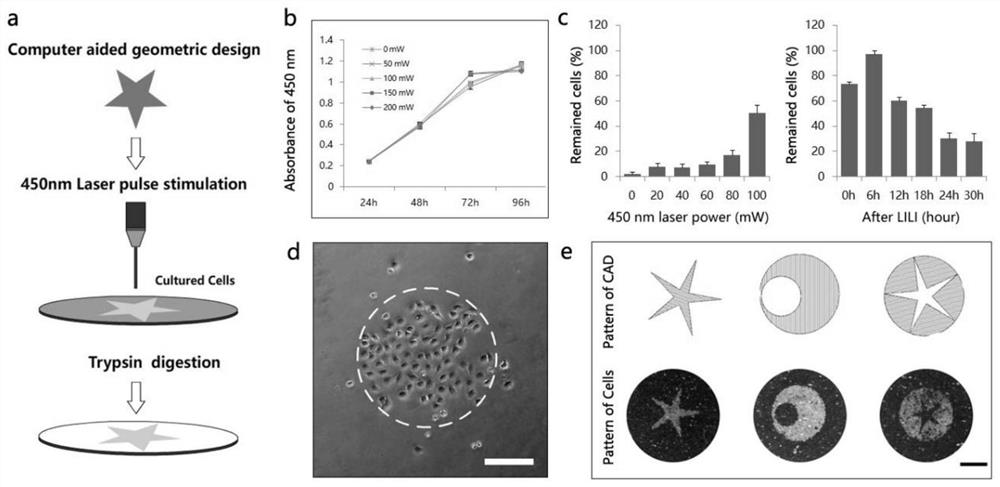Non-invasive cell patterning method and system based on digitally controlled laser radiation
A numerical control laser and laser radiation technology, applied in the field of non-invasive cell patterning methods and systems, can solve the problems of large cell damage, high cost, complicated operation process, etc., and achieve small cell damage, strong versatility, and flexible operation. Effect
- Summary
- Abstract
- Description
- Claims
- Application Information
AI Technical Summary
Problems solved by technology
Method used
Image
Examples
Embodiment 1
[0070] This embodiment provides a specific non-invasive cell patterning method based on digitally controlled laser radiation, wherein the cells are NIH3T3 cells, specifically including:
[0071] 1. The in vitro culture of NIH3T3: take the NIH3T3 cell line under sterile conditions, use DMEM containing 10% fetal bovine serum, penicillin (100U / ml) and streptomycin (100 μg / ml) as the culture medium, at 37 ° C, 5 %CO 2 Cultivate in an incubator, replace the medium after 24 hours, discard non-adherent cells, and change the medium every 2-3 days thereafter. When the cells reached 80% confluency, they were digested with 0.25% trypsin and subcultured.
[0072] 2. Laser pulse stimulation: self-programming laser numerical control software Gcodetranslator1.0 (such as Figure 6 ) can control the position, intensity and time of laser radiation, and can be used with conventional cell culture dishes (96-well plate, 24-well plate, 6-well plate, 35mm culture dish, 60mm culture dish, 100mm cul...
Embodiment 2
[0077] This example is used to discuss the effect of 450nm low-volume laser pulses on the transcriptome expression profile of NIH3T3 cells. Specifically, the 450nm laser was pulsed at 100mW energy for 1s with an interval of 2h for 12 cycles. Samples were collected to extract total RNA for transcriptome sequencing (RNA-seq). The results showed that laser pulse radiation did not affect the expression of cell adhesion molecules and extracellular matrix, but mainly stimulated the cells through oxidative stress, and at the same time up-regulated the binding receptors of lipoproteins, and promoted the association of lipoproteins and membrane receptors in the cell microenvironment. combined ( Figure 4 ). Figure 4 Schematic diagram of the effect of 450nm laser pulses on the function of living cells.
Embodiment 3
[0079] This example discusses that 450nm low-volume laser pulses induce LDL to adhere to the cell surface and at the same time induce cells to resist trypsin digestion, specifically including:
[0080] 1. 450nm low-level laser pulses induced LDL to adhere to the surface of NIH3T3 cells: 450nm laser with 100mW energy, pulsed for 1s, with an interval of 2h, and continued for 12 cycles. Different concentrations of fluorescently labeled LDL were added to the medium. The results showed that under the condition of 1-2 mg / mL LDL, laser pulse radiation could significantly induce the adhesion of LDL on the surface of NIH3T3 cells ( Figure 5 ).
[0081] 2. LDL promotes cell adhesion induced by 450nm low-volume laser pulses under serum-free conditions: culture NIH3T3 cells under serum-free culture conditions, add different concentrations of LDL (0-2mg / mL), 450nm laser with 100mW energy, pulse 1s , with an interval of 2h for 12 cycles. After irradiation, NIH3T3 cells cultured in vitro ...
PUM
 Login to View More
Login to View More Abstract
Description
Claims
Application Information
 Login to View More
Login to View More - R&D Engineer
- R&D Manager
- IP Professional
- Industry Leading Data Capabilities
- Powerful AI technology
- Patent DNA Extraction
Browse by: Latest US Patents, China's latest patents, Technical Efficacy Thesaurus, Application Domain, Technology Topic, Popular Technical Reports.
© 2024 PatSnap. All rights reserved.Legal|Privacy policy|Modern Slavery Act Transparency Statement|Sitemap|About US| Contact US: help@patsnap.com










